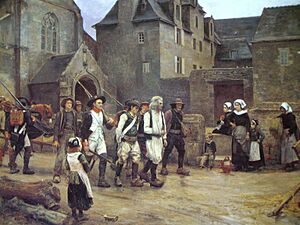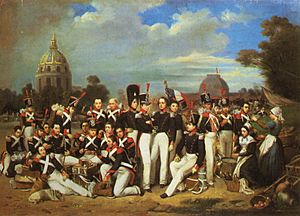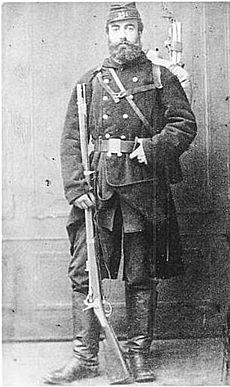National Guard (France) facts for kids
Quick facts for kids National Guard |
|
|---|---|
| Garde nationale | |

Logo of the National Guard (since 2016)
|
|
| Active | 1789–1827 1831–1872 2016–present |
| Country | France |
| Type | Reserve Gendarmerie |
| Size | >77,000 |
| Part of | French Armed Forces National Police |
| Motto(s) | Honneur et Patrie ('Honour and Fatherland') |
| Engagements | (List of wars involving France) |
| Commanders | |
| Minister of the Armed Forces | Sébastien Lecornu |
| Secretary General for the National Guard | General Louis-Mathieu Gaspari |
| Notable commanders |
Gilbert du Motier, marquis de Lafayette |
The National Guard (French: Garde nationale) is a special military group in France. It acts as a reserve for the army, police, and gendarmerie. A gendarmerie is a military force that also does police work.
The National Guard was first created in 1789 during the French Revolution. It was meant to be separate from the regular French Army. Its jobs included keeping order and acting as a backup military force.
For much of its history, the National Guard was seen as loyal to the middle class. However, from 1792 to 1795, it became very revolutionary. The lower-ranking members were linked to the "sans-culottes," who were radical common people.
The National Guard was officially shut down from 1827 to 1830. But it was brought back. After the Franco-Prussian War in 1870–71, the Paris National Guard was again seen as too revolutionary. This led to it being dissolved (shut down) again in 1871.
In 2016, France decided to bring back the National Guard for a second time. This happened because of several terrorist attacks in the country.
Contents
How the National Guard Started
On July 11, 1789, people in Paris were very angry. The King had suddenly fired his finance minister, Jacques Necker. The National Assembly, which was like a new government, talked about forming a "Bourgeois Guard" for Paris.
On July 13, the National Assembly officially created a "Bourgeois Militia." The next day, people looked for weapons for this new group. This search led to the famous storming of the Bastille.
Lafayette became the leader of the Bourgeois Militia on July 14. It was then renamed the "National Guard of Paris." Many soldiers from the King's old French Guards joined this new National Guard. Soon, similar National Guard groups formed in other towns and villages across France. They were created because people feared chaos or a return to the old ways.
At first, each city and village had its own National Guard units. These were run by local governments. But on July 14, 1790, all these units were united under Lafayette. He became the "Commandant General of all the National Guards of the Kingdom."
How the Guard Was Organized
In December 1790, a leader named Robespierre spoke about the National Guard. He wanted it to become an army of citizen-soldiers, separate from the regular army. In 1791, a law said that all "active citizens" (people who could vote) and their children over 18 had to join the National Guard. Their job was to keep law and order. They also had to defend their local area if there was a war.
The National Guard was set up in companies based on districts. Five of these local units formed a battalion. Eight to ten battalions made up a "legion." There were also groups for older volunteers and young citizens. Sometimes, there were mounted groups and artillery units too.
- In 1792, Napoleon Bonaparte, who was 23, started his military career. He was a lieutenant-colonel in a battalion of Corsican Volunteers in the National Guard.
- Chevalier de Saint-Georges was one of the first to join the National Guard in Lille.
On July 11, 1792, the Assembly allowed the National Guard to take part in the Festival of Federation. This was a big national celebration. Soon, all citizens, even those who couldn't vote, were allowed to join the National Guard.
The Guard members kept their weapons and uniforms at home. They would put them on when needed. At first, different units had different colored uniforms. But in 1791, they all started wearing dark blue coats with red collars and white parts. These colors matched the new French flag.
The National Guard: From Revolution to 1827
What the Guard Did During the Revolution
Before the National Guard, the "Guet royal" was in charge of keeping order in Paris. In 1791, the National Guard took over this role. In the summer of 1792, the Guard changed a lot. More radical people joined, and a revolutionary leader named Antoine Joseph Santerre took charge.
After the King was removed (September 21, 1792), the National Guard fought for the Revolution. It helped force the National Assembly to agree with the people's demands.
After July 1794, the new government put the National Guard under more conservative leaders. Some parts of the National Guard then tried to overthrow the government in October 1795. But they were defeated by forces led by Napoleon Bonaparte. After this, the Paris National Guard lost its important political role.
The Guard Under Napoleon
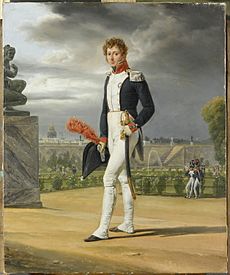
Napoleon didn't think the middle-class National Guard could keep order well. So, he created a "Municipal Guard of Paris." This was a full-time police force that was very military. He didn't get rid of the National Guard completely. He kept it as a backup force. He used it to defend France in 1809 and 1814.
In Paris, the National Guard had 12,000 middle-class property owners. They served part-time and paid for their own equipment. Their main job was to guard public buildings. After Napoleon's terrible campaign in Russia in 1812, many National Guard groups were called up for active duty. They formed new army regiments. Many of these fought in Germany in 1813 and when France was invaded in 1814.
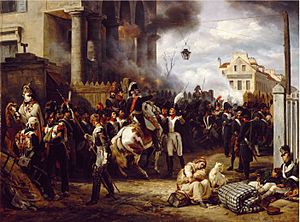
Six thousand National Guardsmen fought in the Battle of Paris in 1814. After Paris was taken by enemy armies, the National Guard grew to 35,000 men. It became the main force for keeping order in the city.
The Guard During the King's Return
When the King returned to power in 1814, Louis XVIII kept the National Guard. At first, the Guard got along well with the King. The future Charles X was its Colonel-General. He often reviewed the Guard.
However, by 1827, the middle-class members of the Guard became unhappy with the King. After some members shouted insults during a review, Charles X dissolved the Guard the next day. He didn't take away their weapons. These muskets reappeared in 1830 during the July Revolution.
The National Guard: 1831 to 1872
A new National Guard was formed in 1831 after the July Revolution of 1830. It helped put down the Paris June Rebellion of 1832. This rebellion was against King Louis-Phillipe. However, the same National Guard later fought in the Revolution of 1848. This time, they supported the republicans. This change showed that King Louis-Phillipe was losing popularity.
The Guard Under Napoleon III
Napoleon III limited the National Guard's power during the Second Empire. He wanted to reduce its liberal and republican influence. During the Franco-Prussian War, the government asked the Guard to defend Paris. This was against the invading Prussian army.
During the Paris Commune uprising (March to May 1871), the Paris National Guard grew even larger. It included all able-bodied citizens who could carry weapons. After the regular French Army defeated the Commune, the National Guard was officially abolished. Its units were disbanded. The Mobile National Guard, which was a rapid deployment force, was also disbanded.
Why the Guard Ended in 1872
Even though the National Guard played a big role in the Franco-Prussian War, it was soon disbanded. This happened after the Third Republic was created. The Guard had changed from a volunteer group to a much larger force of conscripts (people forced to join). It had lost its original purpose.
The regular army also didn't like having such a large armed force outside its direct control. The Paris National Guard's role in the Paris Commune uprising made the army very hostile towards it.
The National Guard was seen as a symbol of the revolutionary "nation in arms" in 1789. But on March 14, 1872, it was formally dissolved. It was seen as a threat to the safety and order of the new Third Republic.
After this, France created "territorial regiments." These were made up of older men who had finished their full-time military service. These reserve units were only called up during a major war. They were part of the regular army.
The National Guard Returns (2016-Today)
After several terror attacks in France, President François Hollande announced a new National Guard. He said it would be formed using existing military reserve forces.
On October 12, 2016, the National Guard was officially brought back. This was after 145 years. It became the fifth service branch of the French Armed Forces. It is now under the Ministry of the Armed Forces.
The new Guard also helps the National Gendarmerie and the National Police. It helps secure big events across the country. It also performs its historical role as a national military and police reserve service.
The new Guard was expected to grow to 72,500 members in 2017. It was planned to reach 86,000 members in 2018. A special budget of 311 million euros helps fund it. Its members come from reserves, the private sector, and active military personnel. Unlike the old Guard, its officers now come from both the Army and the National Gendarmerie. They are graduates of their military academies.
As of 2019, Division General Anne Fougerat is the Secretary-General for the National Guard. She reports to the Chief of Defence Staff and the Minister of the Armed Forces.
Members of the current National Guard wear the same uniforms and rank badges as the Army. Officers wear the rank badges of their specific service branch.


